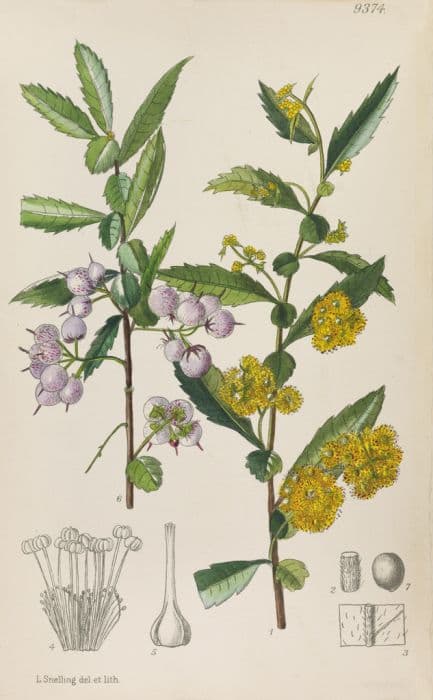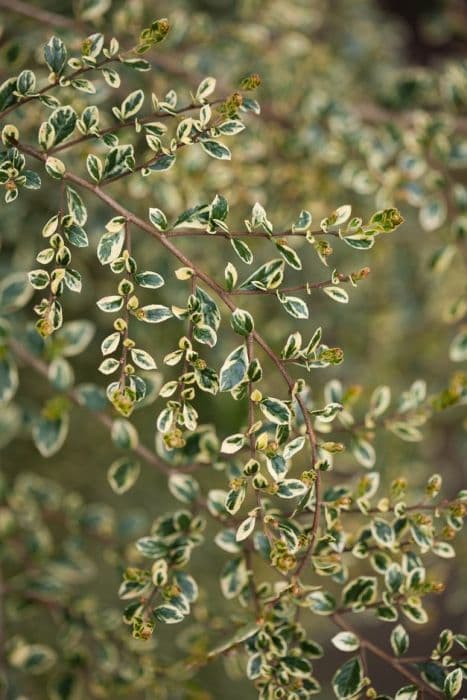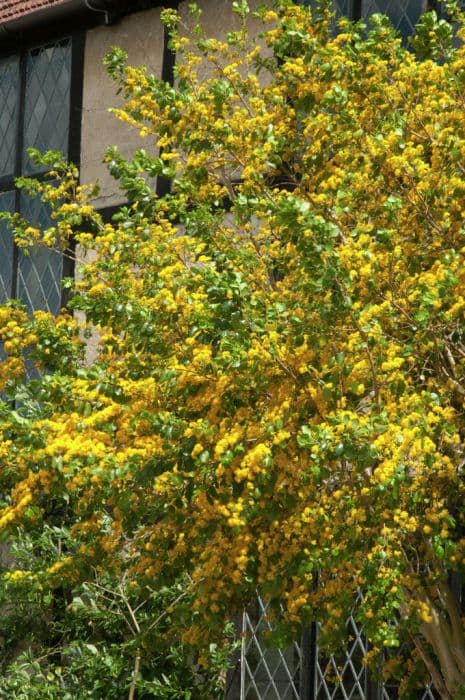Willow Salix acutifolia 'Blue Streak' (m)

ABOUT
Salix acutifolia 'Blue Streak', commonly known as the sharp-leaf willow, is a striking plant that boasts a multitude of characteristics that capture the eye. At first glance, one can't help but notice the unique coloration of the foliage. The leaves have a blue-green hue that shimmers under the sunlight, creating a silvery effect that highlights the slender, elongated shape of the leaves. These leaves are finely pointed, giving the plant a delicate and sharp appearance. The branches exhibit a graceful arching habit, which adds to the overall elegance of the sharp-leaf willow. The bark of the plant is typically dark, contrasting beautifully with the brighter colors of the leaves. During the growing season, the foliage remains dense, creating a full-bodied appearance. When it comes to the reproductive elements, the sharp-leaf willow develops catkins, which are the flower structures characteristic of willows. These can add texture to the plant with their elongated form and often enhance the visual interest of the sharp-leaf willow. Throughout the seasons, the sharp-leaf willow demonstrates a transformation as its leaves take on different colors in the fall before they drop, completing the cycle of growth with a display of hues that can range from yellow to brownish tones. This seasonal change further enriches the beauty of the plant and marks the passage of time in a garden setting. Overall, the sharp-leaf willow 'Blue Streak' is admired for its distinctive coloration, graceful structure, and seasonal variability, contributing to its popularity as an ornamental plant in gardens and landscapes.
About this plant
 Names
NamesFamily
Salicaceae
Synonyms
Blue Streak Willow, Sharp-Leaf Willow, Pointed Willow
Common names
Salix acutifolia 'Blue Streak' (m).
 Toxicity
ToxicityTo humans
The plant in question, commonly known as the willow, is not typically considered toxic to humans. Most parts of willow trees, including Salix acutifolia 'Blue Streak', contain salicin, which is a precursor to aspirin. While not inherently poisonous, excessive ingestion of willow bark or leaves could potentially cause adverse effects similar to those of aspirin overdose, which might include stomach pain, nausea, vomiting, and in severe cases, more serious effects like tinnitus, electrolyte imbalance, and metabolic acidosis. It is crucial to use willow-derived products, such as willow bark for medicinal purposes, under the guidance of a healthcare professional to avoid any potential toxicity.
To pets
Willow, including Salix acutifolia 'Blue Streak', is not generally considered toxic to pets. The salicin found in willow may have mild therapeutic effects in small doses, as it is related to aspirin. However, consumption of large amounts of willow bark or leaves could potentially lead to aspirin toxicity in pets, especially in cats, which are more sensitive to salicylates. Symptoms of salicylate poisoning in pets can include vomiting, diarrhea, anorexia, depression, bleeding disorders, and in severe cases, kidney or liver failure. It is always best to keep an eye on pets around garden plants and to consult a veterinarian if you suspect that your pet has eaten a potentially harmful plant.
 Characteristics
CharacteristicsLife cycle
Perennials
Foliage type
Deciduous
Color of leaves
Blue-green
Height
15-20 feet [4.6-6 meters]
Spread
10-15 feet [3-4.6 meters]
Plant type
Shrub
Hardiness zones
4-8
Native area
Eurasia
Benefits
 General Benefits
General Benefits- Ornamental value: 'Blue Streak' provides visual interest due to its unique blue-tinged foliage and attractive growth habit.
- Low Maintenance: This willow variety is often easy to care for, requiring minimal maintenance once established.
- Fast Growth: Salix acutifolia 'Blue Streak' is known for its rapid growth rate, which can quickly provide landscape impact or privacy screening.
- Habitat Creation: The plant can provide habitat and food for a variety of wildlife, including birds and insects.
- Erosion Control: Willows are excellent for stabilizing soil and preventing erosion, especially along water bodies.
- Soil Improvement: They have the ability to improve soil health and fertility through leaf litter and root activity.
- Tolerance of Wet Soils: 'Blue Streak' is particularly well-suited for wet areas where other plants might struggle, making it ideal for riparian plantings.
- Windbreak: Their dense growth can serve as a windbreak, protecting other plants and reducing wind erosion.
 Medical Properties
Medical PropertiesThis plant is not used for medical purposes.
 Air-purifying Qualities
Air-purifying QualitiesThis plant is not specifically known for air purifying qualities.
 Other Uses
Other Uses- Livestock Fodder: Willows, including Salix acutifolia, can provide a nutritious supplement to the diets of livestock, primarily small ruminants like sheep and goats.
- Wildlife Habitat: Dense willow plantings offer excellent cover and nesting sites for birds and small mammals.
- Stormwater Management: Due to their love of water, willows can be planted in areas where stormwater needs to be absorbed or cleaned, helping to reduce runoff.
- Erosion Control: The root systems of willow trees help to stabilize banks along rivers and streams, preventing soil erosion.
- Windbreaks: Tall varieties of willows can be used to create windbreaks that protect smaller plants and reduce soil erosion caused by wind.
- Ornamental Use: The "Blue Streak" willow can be cultivated for its attractive foliage and unique growth form in ornamental gardens.
- Living Structures: Flexible willow branches can be woven to create living fences, arbors, or tunnels in gardens and parks.
- Art and Craft Materials: Willow branches are traditionally used for making wicker baskets, furniture, and other crafts.
- Noise Reduction: Planted in dense rows, willows can help to dampen noise pollution from roads or industrial areas.
- Stream Remediation: Planting willows along streams can help to filter and trap sediments, improving the water quality in the process.
Interesting Facts
 Feng Shui
Feng ShuiThe Willow is not used in Feng Shui practice.
 Zodiac Sign Compitability
Zodiac Sign CompitabilityThe Willow is not used in astrology practice.
 Plant Symbolism
Plant Symbolism- Flexibility and Resilience: As a willow variety, Salix acutifolia 'Blue Streak' symbolizes flexibility and resilience. Willow trees, known for their pliable branches, can bend without breaking, which is often associated with the ability to adapt to life's challenges without giving up.
- Growth and Renewal: Willows are fast-growing trees that can regenerate from a single fallen branch, making them a symbol of renewal and the idea that one can start anew and grow despite adversity.
- Healing: Historically, the willow tree has been associated with healing due to the presence of salicylic acid in its bark, which is a compound similar to aspirin. It represents the healing of emotional and physical pain.
- Sorrow: The weeping form of some willow species can evoke a sense of melancholy or sorrow. The willow can symbolize the need to let go of pain or grief, as it 'weeps' with the beholder.
- Inner Vision and Dreams: Some cultures regard the willow as a tree that is connected to the world of dreams and inner visions, suggesting an association with the subconscious and intuitive insight.
 Water
WaterThe Purple Willow should be watered deeply so that water reaches the entire root system, especially during dry periods. Establish a watering routine that ensures the soil remains moist but not waterlogged, as it is a willow species that thrives in moist environments. During the first growing season, water the newly planted willow at least once a week with approximately 1 to 2 gallons, depending on the size of the plant and weather conditions. Once established, Purple Willow trees can tolerate short periods of drought, but regular watering every two weeks with about 2 gallons will keep it thriving. Adjust your watering schedule during very hot or dry weather, as the tree may need more frequent watering.
 Light
LightPurple Willow trees flourish best in full sun or partial shade. Planting them in a spot where they receive at least six hours of direct sunlight daily is ideal to promote vigorous growth and good health. They can tolerate light shade, but prolonged shade may lead to reduced growth and less dense foliage.
 Temperature
TemperaturePurple Willow trees can endure a wide range of temperatures, from as low as -30°F to as high as 100°F, but they grow best in temperate climates. They prefer to be grown in areas where the average temperature is between 50°F and 75°F. Short periods outside this range are typically tolerated, as long as the fluctuations are not too extreme or prolonged.
 Pruning
PruningPrune Purple Willow trees in late winter or early spring when the tree is dormant to encourage new growth and maintain a desired shape. Prune annually to remove dead or damaged branches, improve air circulation, and control the size of the tree. The best time for heavy pruning is every three to five years, to rejuvenate older trees and encourage healthy, vigorous shoots.
 Cleaning
CleaningAs needed
 Soil
SoilThe Willow 'Blue Streak' prefers moist, well-drained soil with a mix of loam, sand, and some organic content. A balanced pH of 6.0 to 7.5 is suitable for this plant. Amend heavy clay soils or sandy soils with compost to improve fertility and texture.
 Repotting
RepottingWillow 'Blue Streak' generally does not require frequent repotting as it is typically grown as an outdoor plant. Repot young plants if they outgrow their containers, which may be every 2 to 3 years. Mature willows are seldom repotted.
 Humidity & Misting
Humidity & MistingWillows like 'Blue Streak' are adaptable to a range of humidity levels and thrive in outdoor conditions. They do not require specific humidity levels, making them versatile in various climates.
 Suitable locations
Suitable locationsIndoor
Provide bright light, keep soil damp, and ensure good air circulation.
Outdoor
Plant in sun, ensure moist soil, protect from strong winds.
Hardiness zone
4-8 USDA
 Life cycle
Life cycleSalix acutifolia 'Blue Streak', commonly known as the Sharp-leaf Willow, begins its life cycle with seed germination, typically taking place in moist, well-draining soil conditions. The seeds quickly sprout and the plant enters a rapid growth phase where it establishes a strong root system and begins to develop its characteristic narrow, bluish leaves and multiple stems. As it matures, the Sharp-leaf Willow enters a vegetative stage characterized by the elongation of its stems and the expansion of its foliage, offering support for photosynthesis and energy production. Following vegetative growth, it enters the reproductive phase, producing catkins that facilitate pollination by insects or wind, leading to seed development. Once fertilization occurs, seeds are dispersed from the mature catkins, often by water, as they are adapted to float and colonize new areas. Finally, after reaching maturity and completing several reproductive cycles, the plant will eventually senesce and die, completing its life cycle.
 Propogation
PropogationPropogation time
Spring-Early Summer
The Salix acutifolia 'Blue Streak', commonly known as Blue Streak Willow, is commonly propagated through hardwood cuttings. The best time to propagate is during the plant's dormancy in late fall or winter. To propagate, take cuttings about 6 to 12 inches (15 to 30 cm) in length from healthy, mature stems. The bottom cut should be made at an angle just below a bud, and the top cut straight across just above a bud to maximize growth potential. Before planting, the cut end can be dipped in rooting hormone to encourage root development. The cuttings should then be inserted into a well-draining soil medium with about two-thirds of their length below the surface. Water the cuttings and keep the soil consistently moist until roots have established, after which the new willow may be transplanted to a permanent location.









